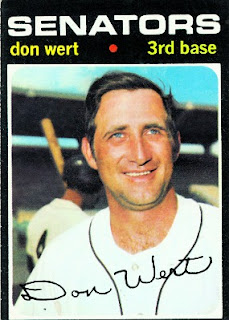That same technique made its way into the 1960s as well. It wasn’t used for whole sets, but instead – I would imagine – for players whose pictures they couldn’t find, or showed them in a completely different uniform, or were of particularly poor quality. Alternatively, these guys could simply have been in the Federal Witness Protection Program. I don’t know.
So, here you go, more masterpieces from those modern Michelangelos over at the Topps Company, US Sports & Entertainment Division …
Pretty normal. In fact, this might just be a photo, with some heavy touch up. A quick Google Images search of “Cookie Rojas,” though, tells me that Cookie never looked this good before in his life. If you doubt me, just check out these loser specs from a few years down the road: here, here, and here.
I already included a pretty detailed bio of Cookie there. But did you know his real name was “Octavio”? Not sure how they got “Cookie” out of that. I guess “Ockie” just wasn’t cutting it.
Yup, this guy really did look like this. I’ve seen photographs. Poor schmuck.
Jose Tartabull was up for nine years and 1,857 at bats. Interestingly, he hit only two home runs in that period. His son Danny hit as many in his first ten games in the majors. Danny was a lot better looking too. Man, those light-hitting outfielders get all the chicks.
Okay, now we’re getting into a little weirdness. For some reason, Don has that beatific look I’ve only ever seen before on prayer cards and portraits in The Lives of the Saints.
Don was nowhere near this beatific looking. In fact, there’s a 1970 card where he looks old and grizzled enough to be easily confused with the manager …
Less than ten years separate these two cards. How can that be? A lot must have happened in that time.
Don Wert was a pretty reliable third baseman for the Tigers through most of the ‘60s. He got into one All Star game and beat out Brooks Robinson to lead the AL in fielding one year.
Don was part of that crazy eight-player trade that sent Denny McLain to D.C. Don got into 20 games with the sad-sack Senators, hit .050, and promptly retired. Extensive bio right here.
This guy simply doesn’t look real. I think they just made him up. Chuck Schilling, huh? Have you ever heard of this guy?
Turns out Chuck was Boston’s starting second baseman in 1961, leading the league in plate appearances and fielding, and coming in third for Rookie of the Year. Unfortunately, a bad wrist injury took a major toll, and he was out of the bigs in just a couple more years.
Nope, no relation to that other Boston Schilling – Chris or Carl or Knute or whatever his name was.
So, if I told you we were going to paint your portrait instead of just taking your photo, you’d think we might touch things up a little, smooth some of those corners, spiff you up a bit, right? But, then again, maybe not.
Not too much to say about ol’ Jack, I’m afraid. Here’s his complete Wikipedia entry:
Jack Patrick Curtis (January 11, 1937 in Rhodhiss, North Carolina) is a former Major League Baseball pitcher who played for three seasons. He played for the Chicago Cubs from 1961 to 1962, the Milwaukee Braves in 1962, and the Cleveland Indians in 1963.
* - author has this card































